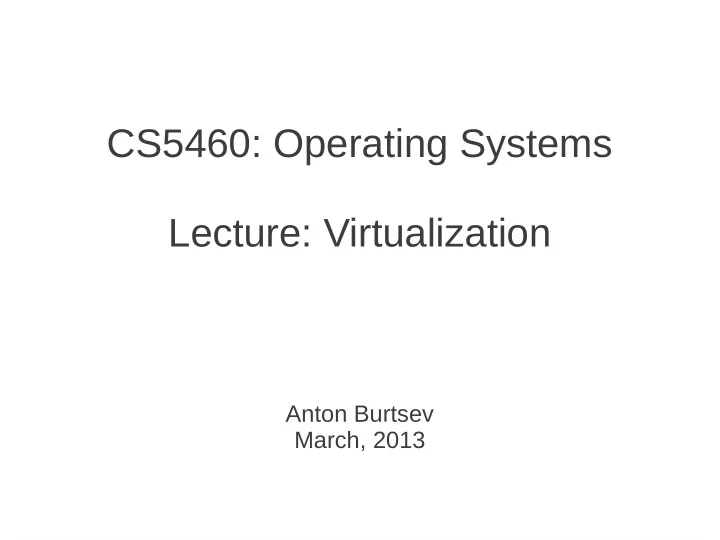

CS5460: Operating Systems Lecture: Virtualization Anton Burtsev March, 2013
Traditional operating system
Virtual machines
A bit of history ● Virtual machines were popular in 60s-70s ● Share resources of mainframe computers [Goldberg 1974] ● Run multiple single-user operating systems ● Interest is lost by 80s-90s ● Development of multi-user OS ● Rapid drop in hardware cost ● Hardware support for virtualizaiton is lost
What is the problem? ● Hardware is not designed to be multiplexed ● Loss of isolation
Virtual machine Efficient duplicate of a real machine ● Compatibility ● Performance ● Isolation
Trap and emulate
What needs to be emulated? ● CPU and memory ● Register state ● Memory state ● Memory management unit ● Page tables, segments ● Platform ● Interrupt controller, timer, buses ● BIOS ● Peripheral devices ● Disk, network interface, serial line
x86 is not virtualizable ● Some instructions ( sensitive ) read or update the state of virtual machine and don't trap ( non- privileged ) ● 17 sensitive, non-privileged instructions [Robin et al 2000]
x86 is not virtualizable (II) ● Examples ● popf doesn't update interrupt flag (IF) – Impossible to detect when guest disables interrupts ● push %cs can read code segment selector (%cs) and learn its CPL – Guest gets confused
Solution space ● Parse the instruction stream and detect all sensitive instructions dynamically ● Interpretation (BOCHS, JSLinux) ● Binary translation (VMWare, QEMU) ● Change the operating system ● Paravirtualization (Xen, L4, Denali, Hyper-V) ● Make all sensitive instructions privileged! ● Hardware supported virtualization (Xen, KVM, VMWare) – Intel VT-x, AMD SVM
Basic blocks of a virtual machine monitor: QEMU example
Interpreted execution: BOCHS, JSLinux
What does it mean to run guest? ● Bochs internal emulation loop ● Similar to non- pipelined CPU like 8086 ● How many cycles per instruction?
Binary translation: VMWare
VMWare Workstation
Address space during the world switch
The world switch ● First, save the old processor state: general-purpose registers, privileged registers, and segment registers; ● Then, restore the new address space by assigning %cr3. All page table mappings immediately change, except the one of the cross page. ● Restore the global segment descriptor table register (%gdtr). ● With the %gdtr now pointing to the new descriptor table, restore %ds. From that point on, all data references to the cross page must use a different virtual address to access the same data structure. However, because %cs is unchanged, instruction addresses remain the same. ● Restore the other segment registers, %idtr, and the general- purpose registers. ● Finally, restore %cs and %eip through a longjump instruction.
Protecting the VMM
Translator continuations
Interpreted execution revisited: Bochs
Instruction trace cache ● 50% of time in the main loop ● Fetch, decode, dispatch ● Trace cache (Bochs v2.3.6) ● Hardware idea (Pentium 4) ● Trace of up to 16 instructions (32K entries) ● 20% speedup
Improve branch prediction ● 20 cycles penalty on Core 2 Duo
Improve branch prediction ● Split handlers to avoid conditional logic ● Decide the handler at decode time (15% speedup)
Resolve memory references without misprediction ● Bochs v2.3.5 has 30 possible branch targets for the effective address computation Effective Addr = (Base + Index*Scale + Displacement) ● mod(2^AddrSize) ● e.g. Effective Addr = Base , Effective Addr = Displacement ● 100% chance of misprediction ● Two techniques to improve prediction: ● Reduce the number of targets: leave only 2 forms ● Replicate indirect branch point ● 40% speedup
Time to boot Windows
Cycle costs
References ● A Comparison of Software and Hardware Techniques for x86 Virtualization. Keith Adams, Ole Agesen, ASPLOS'06 ● Bringing Virtualization to the x86 Architecture with the Original VMware Workstation. Edouard Bugnion, Scott Devine, Mendel Rosenblum, Jeremy Sugerman, Edward Y. Wang, ACM TCS'12. ● Virtualization Without Direct Execution or Jitting: Designing a Portable Virtual Machine Infrastructure. Darek Mihocka, Stanislav Shwartsman.
Recommend
More recommend